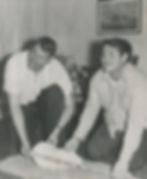The Migrating Bigfoot
- Hannah Rogers
- Oct 13, 2021
- 4 min read
Cryptids are those strange, and sometimes monstrous, creatures that we’re not sure actually exist or not. Bigfoot, the Loch Ness Monster, and Mothman are some of the most well known of these mysterious monsters. The Antelope Valley is home to a couple cryptids of its own, with witnesses unsure of what exactly they’ve seen, only that it’s something out of the ordinary.
The most famous cryptid of the AV is definitely Bigfoot. Supposedly, a migrating Sasquatch passes through the Tehachapi Mountains, skirting around Lancaster, Quartz Hill, and Palmdale to get to the San Gabriel Mountains. During the 1970s Bigfoot craze, enthusiasts Rich Grumley and Floyd Smith suggested that sightings increased in the winter due to the creature seeking warmer climates. Sightings in Lancaster and Palmdale typically peak in February, and are usually in the foothills or near Saddleback Butte.

Bigfoot is said to stand at a towering 12 feet in height. With an estimated weight of between 800 and 1000 pounds, and covered in thick, shaggy hair, Bigfoot is a sight not forgotten by the people who spot them. With a high sloping forehead, and exposed leathery skin on the face, hands and feet, Bigfoot is thought to be some unknown species of ape. Some witnesses have also said that they smelled the giant before seeing it, describing a foul, “skunk-like” odor that only disappeared after the creature had gone.
Though no pictures of the Southern California Sasquatch have been taken, California remains a hotspot for Bigfoot sightings. In the 1970s, the Antelope Valley saw a particular zeal in finding the creature, with locals regularly documenting sightings and even taking plaster casts of footprints. These footprints are a massive 19 to 22 inches in length and 10 inches in width. The creature’s strides are said to be a full five feet.
Grumley and Smith, who were the president and vice-president of the California Bigfoot Organization, respectively, headed the search for Bigfoot in the 1970s. Grumley, Smith, and other CBFO members tracked sightings, interviewed witnesses, and combed the countryside for any sign of the elusive creature. When footprints were found, Grumley attempted to recreate them in order to determine their authenticity. Grumley, a big man at 6’ 5” and 290 lbs, and going at a running leap, was unable to match the force of the footprints. This led him to believe that the footprints were genuine.

Bigfoot enthusiasts suggest that the creatures’ diets are primarily made up of fruits, nuts, and small animals, based on evidence gathered on migration trails. Sasquatch are generally thought to be peaceful—in most sightings they appear crouched over, cautious, and curious. However, other anecdotes suggest that Bigfoot enjoys meat and will resort to raiding ranches for livestock. Grumley and Smith interviewed witnesses who had seen a more frightening side of these cryptids. Among those witnesses interviewed was a turkey rancher who claimed that over 600 birds disappeared after a sighting.
The birds were sick with Newcastle disease and had already died by the time of the sighting, but were awaiting cremation. The birds were kept in a secure place to avoid spreading infection to healthy animals, but somehow the turkeys all disappeared without a trace.
Another man, a prospector, to work with Grumley and Smith claimed to have had a horrifying encounter with seven Sasquatch back in 1939. Looking for gold in the Borrego Badlands, the prospector built a temporary camp for himself and his two mules against the canyon walls. In the middle of the night, he woke to his burros stirring with fear.
Beyond his campfire, he saw a troop of massive creatures covered in shaggy, gray fur and standing upright. One mule was able to break free of its restraints and retreat behind the fire with the prospector, but the other was set upon by the gargantuan apes. The prospector watched in horror as his mule was devoured raw right in front of him.
The only thing that seemed to deter the group of Bigfoots was the prospector’s fire. He kept it stoked throughout the night, watching for the creatures the entire time. As the sun rose, he at last saw the monsters retreating, and was able to make his own escape from the desert Sasquatch.
There are few recorded attacks on humans by Bigfoot. Those few reports are said to have occurred before the 1930s and were provoked. Despite this, the eerie stories told to Grumley and Smith may have you watching your step if you go hiking in the desert. Keep an eye (and camera) out for gargantuan footprints and keep your nose open for a skunk-like stench, and give these mysterious monsters a wide berth.

Sources:
MOAH Collections
"Bigfoot prints believed found by Valley men," Ledger-Gazette, Vol. 86, No. 35. February 18, 1972.
MacKenzie, Bill. “Palmdale man hopes to launch expedition to capture Bigfoot in Borrego Badlands,” Daily Ledger-Gazette. September 21, 1971.
Varner, Gary. “Search for evidence of man-animal spreads around the world,” Daily Ledger-Gazette. March 21, 1974.
Wheeler, Chuck. “February may be Big Foot’s most active month,” Daily Ledger-Gazette. January 9. 1973.
